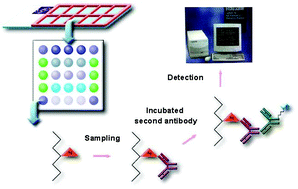Screening of specific antigens for SARS clinical diagnosis using a protein microarray
Abstract
In this study several SARS-CoV structural

- This article is part of the themed collection: Coronavirus articles - free to access collection
* Corresponding authors
a
Beijing Institute of Radiation Medicine, Beijing, People's Republic of China
E-mail:
sqwang@nic.bmi.ac.cn
Fax: +86-10-68214653
Tel: +86-10-66932211 and +86-10-66931422
In this study several SARS-CoV structural

 Please wait while we load your content...
Something went wrong. Try again?
Please wait while we load your content...
Something went wrong. Try again?
D. Lu, S. Chen, S. Zhang, M. Zhang, W. Zhang, X. Bo and S. Wang, Analyst, 2005, 130, 474 DOI: 10.1039/B415888A
To request permission to reproduce material from this article, please go to the Copyright Clearance Center request page.
If you are an author contributing to an RSC publication, you do not need to request permission provided correct acknowledgement is given.
If you are the author of this article, you do not need to request permission to reproduce figures and diagrams provided correct acknowledgement is given. If you want to reproduce the whole article in a third-party publication (excluding your thesis/dissertation for which permission is not required) please go to the Copyright Clearance Center request page.
Read more about how to correctly acknowledge RSC content.
 Fetching data from CrossRef.
Fetching data from CrossRef.
This may take some time to load.
Loading related content
